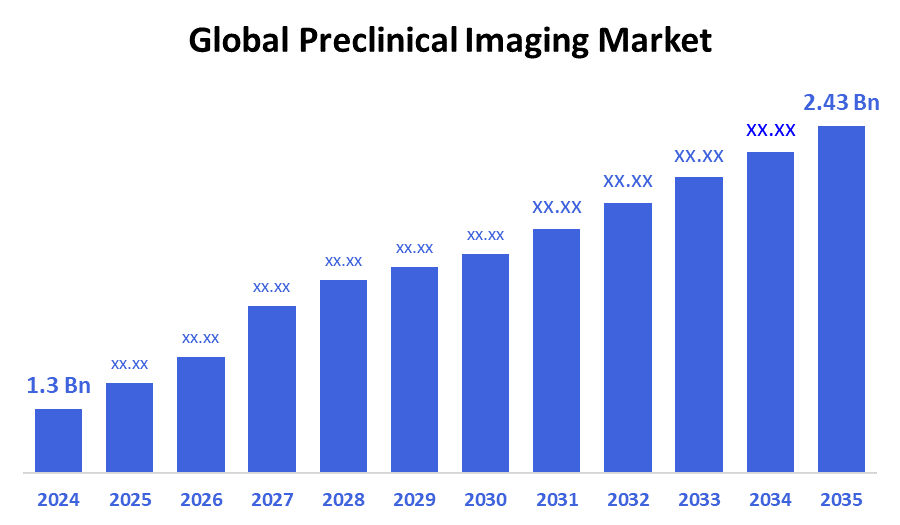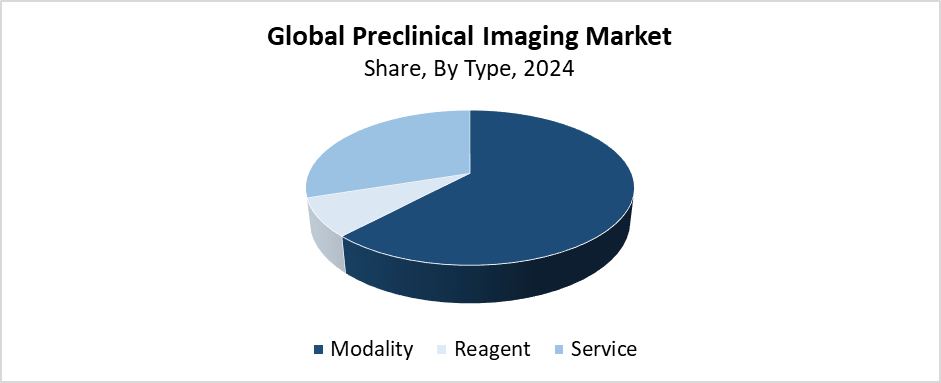Global Preclinical Imaging Market
Global Preclinical Imaging Market Size, Share, and COVID-19 Impact Analysis, By Type (Modality, Reagents, And Service), By End Use (Pharma and Biotech Companies, Contract Research Organizations (CROs), Academic and Research Institutes, Others), and By Region (North America, Europe, Asia-Pacific, Latin America, Middle East, and Africa), Analysis and Forecast 2025-2035
Report Overview
Table of Contents
Preclinical Imaging Market Summary
The Preclinical Imaging Market Size Was Estimated at USD 1.3 Billion in 2024 and is Expected to Reach USD 2.43 Billion by 2035, Growing at a CAGR of 5.85% from 2025 to 2035. Increased R&D expenditure in drug development, the development of multimodal imaging technologies (such as MRI, optical, and PET), the rising demand for non-invasive animal imaging, and increased government and regulatory support for biomedical research are the main factors propelling the preclinical imaging market's expansion.

Key Regional and Segment-Wise Insights
- In 2024, the preclinical imaging market in North America accounted for the largest revenue share of 45.72% and led the global market.
- In 2024, the modality segment had the largest market share by type, accounting for 62.83%.
- In 2024, the pharma and biotech companies segment had the largest market share based on end use.
Global Market Forecast and Revenue Outlook
- 2024 Market Size: USD 1.3 Billion
- 2035 Projected Market Size: USD 2.43 Billion
- CAGR (2025-2035): 5.85%
- North America: Largest market in 2024
The preclinical imaging market consists of imaging technologies that allow scientists to visualize biological processes and monitor disease progression and therapeutic effects in animal models before human clinical trials start. This sector includes multiple imaging modalities, namely optical imaging, positron emission tomography (PET), and magnetic resonance imaging (MRI), as well as computed tomography (CT) and single-photon emission computed tomography (SPECT). The market experiences growth because pharmaceutical and biotechnology firms invest more in preclinical research, together with the rising number of chronic diseases and the increasing requirement for efficient drug development methods. The worldwide market expansion occurs because of growing interest in precise non-invasive imaging techniques that deliver real-time results, which minimize animal testing while improving research outcomes.
The preclinical imaging market experiences substantial changes because of technological progress, including hybrid imaging systems constructed from PET/MRI and enhanced imaging software and artificial intelligence applications for better picture analysis. Biomedical research, along with complex imaging infrastructure, receives backing from government financial support programs, which drive market growth. The rising adoption of preclinical imaging stems from regulatory requirements for safer and faster drug development, which establishes this technology as essential for modern pharmaceutical and medical investigation.
Type Insights

What Factors Enabled the Modality Segment to Capture a 62.83% Revenue Share in the Preclinical Imaging Market in 2024?
The modality segment held the largest revenue share of 62.83% and led the preclinical imaging market in 2024. The widespread application of imaging modalities such as MRI, PET, CT, SPECT, ultrasound, and optical imaging in preclinical research accounts for their market dominance. These tools serve an essential function by providing complete anatomical, physiological, and molecular data from small animal models so scientists can monitor diseases and test new treatments without invasive methods. The rising demand derives from the growing adoption of multi-modality systems, including PET/CT and PET/MRI, which combine structural and functional imaging abilities. The modality segment maintains its leading market position because of continuous technological breakthroughs combined with increasing research and development funding from biotech and pharmaceutical companies.
The preclinical imaging market's service segment is anticipated to grow at the fastest CAGR throughout the forecast period. Imaging services are increasingly outsourced to university institutions and specialist contract research organizations (CROs) because organizations want to reduce costs while increasing productivity. Companies within the biotechnology and pharmaceutical sectors prefer external service providers to obtain advanced imaging technology and specialized expertise, along with quick delivery without large financial investments. The rising demand for precise imaging data, together with growing preclinical research complexity, leads to higher adoption rates of imaging services. The rapid expansion of this market will occur because research pipelines expand and regulatory standards become more demanding, thus increasing the need for dependable, scalable imaging services.
End Use Insights
How Did the Pharma and Biotech Companies Segment Capture the Largest Revenue Share in the Preclinical Imaging Market in 2024?
The pharma and biotech companies segment led the preclinical imaging market with the largest revenue share in 2024. The key factor behind this market leadership is the increasing requirement for sophisticated imaging systems that support both drug development and safety testing and drug discovery processes. Preclinical imaging allows businesses to precisely and minimally invasively monitor animal model toxicity while tracking drug performance and investigating disease mechanisms. Modern imaging modalities provide strong support for both accelerated research timelines and enhanced data quality, which proves essential as pharmaceutical pipelines expand and market competition intensifies. The segment retains its market dominance due to increased R&D expenditures and strategic imaging services partnerships, as well as the growing demand for personalized treatment approaches.
Throughout the projected period, the contract research organizations (CROs) segment is anticipated to grow at the fastest CAGR. The market expansion results from pharmaceutical and biotechnology companies together with medical device firms, who delegate their preclinical studies to third-party providers to decrease expenses and accelerate product development and access specialized imaging solutions. Businesses use CROs to meet regulatory requirements by obtaining adaptable imaging solutions that maintain high-quality standards and allow them to focus on their core research and development work. The adoption of CRO services receives support from AI-based image analysis advancements, as well as the increasing complexity of drug research and the rising demand for multi-modality imaging. The market growth depends heavily on CROs because preclinical research requires effective and cost-efficient solutions.
Regional Insights
The global preclinical imaging market was led by the North America region with the largest revenue share of 45.72% in 2024. The region leads because of its advanced research facilities, together with substantial research and development funding by pharmaceutical companies, and the broad adoption of modern imaging systems. Major academic institutions, along with leading market companies, support the region's innovation while driving its growth. Preclinical imaging solutions experience strong market demand because medical research receives major government funding and chronic diseases affect many people, and numerous drug development projects exist. The worldwide preclinical imaging market finds its leading position in North America because of regulatory support, along with expanding partnerships between CROs and research institutions.
Europe Preclinical Imaging Market Trends
The European preclinical imaging market held a significant revenue share in 2024 because of biomedical research funding and established pharmaceutical and biotechnology sectors. The area benefits from solid healthcare systems, together with government and European Union funding for research projects, and a rising interest in medical drug development. The preclinical market expanded because research institutions and academic units adopted more advanced imaging technologies. Research organizations now gain better access to specialized imaging services through their collaborations with contract research organizations (CROs). The European preclinical imaging market maintains its upward trajectory due to leading market participants and rigorous drug development regulations, which focus on patient safety and product efficacy.
Asia Pacific Preclinical Imaging Market Trends
The Asia Pacific preclinical imaging market grows significantly because of pharmaceutical R&D investment growth alongside rising healthcare expenses and biotechnology sector development in China, India, Japan, and South Korea. The rising investment in drug research through government funding has led to higher demand for advanced preclinical imaging systems across the region. The increasing number of clinical trials and rising chronic disorder rates have led to greater promotion of non-invasive imaging methods during early research stages. The Asia Pacific region attracts global pharmaceutical companies because it provides both low-cost research services and affordable manufacturing operations for preclinical investigations. Research infrastructure development in the Asia Pacific will drive the area to become the fastest-growing region within the global preclinical imaging market.
Key Preclinical Imaging Companies:
The following are the leading companies in the preclinical imaging market. These companies collectively hold the largest market share and dictate industry trends.
- Cubresa Inc.
- TriFoil Imaging
- Mediso Ltd.
- Bruker Corporation
- Aspect Imaging
- FUJIFILM VisualSonics
- MR Solutions
- Revvity (PerkinElmer, Inc)
- Rigaku (MILabs B.V.)
- Siemens Healthineers
- Others
Recent Developments
- In February 2024, Bruker Corporation acquired Spectral Instruments Imaging (SII), one of the leading companies for preclinical in-vivo optical imaging systems. This acquisition expands Bruker's preclinical imaging portfolio, enhancing its capabilities in molecular imaging and expanding its offerings for life science research and drug development.
- In May 2023, formerly a division of PerkinElmer, Revvity began as a stand-alone provider of scientific solutions. With this division, Revvity can concentrate on its goal of advancing innovation from discovery to cure while offering solutions for the diagnostics and life sciences markets.
Market Segment
This study forecasts revenue at global, regional, and country levels from 2020 to 2035. Decision Advisors has segmented the preclinical imaging market based on the below-mentioned segments:
Global Preclinical Imaging Market, By Type
- Modality
- Reagent
- Service
Global Preclinical Imaging Market, By End Use
- Pharma and Biotech Companies
- Contract Research Organizations (CROs)
- Academic and Research Institutes
- Others
Global Preclinical Imaging Market, By Regional Analysis
- North America
- US
- Canada
- Mexico
- Europe
- Germany
- UK
- France
- Italy
- Spain
- Russia
- Rest of Europe
- Asia Pacific
- China
- Japan
- India
- South Korea
- Australia
- Rest of Asia Pacific
- South America
- Brazil
- Argentina
- Rest of South America
- Middle East & Africa
- UAE
- Saudi Arabia
- Qatar
- South Africa
- Rest of the Middle East & Africa
Check Licence
Choose the plan that fits you best: Single User, Multi-User, or Enterprise solutions tailored for your needs.
We Have You Covered
- 24/7 Analyst Support
- Clients Across the Globe
- Tailored Insights
- Technology Tracking
- Competitive Intelligence
- Custom Research
- Syndicated Market Studies
- Market Overview
- Market Segmentation
- Growth Drivers
- Market Opportunities
- Regulatory Insights
- Innovation & Sustainability
Report Details
| Pages | 240 |
| Delivery | PDF & Excel via Email |
| Language | English |
| Release | Sep 2025 |
| Access | Download from this page |
